Making the switch to solar energy is an exciting step towards a sustainable future and reducing your carbon footprint. However, as with any major home improvement project, installing rooftop solar panels can come with its own set of challenges. Being aware of these potential obstacles can help you prepare and navigate them more smoothly. In this blog, we'll explore six common challenges faced during rooftop solar installation and provide insights to help you overcome them.
1. Structural Integrity Concerns
One of the primary challenges when installing rooftop solar panels is ensuring that your roof can support the additional weight and wind load. Solar panels, though relatively lightweight, can still add significant stress to your roof's structure, especially when combined with mounting hardware and potential wind forces. An inspection by a professional is crucial to assess your roof's condition and determine if reinforcements or repairs are necessary before proceeding with the installation.
Solution: Hire a reputable solar company that employs structural engineers to evaluate your roof's integrity. They can recommend the necessary reinforcements or repairs to ensure your roof can handle the added weight and wind loads safely.
2. Shading Issues
Solar panels rely on direct sunlight to generate electricity effectively. Any obstruction that casts shadows on the panels, such as nearby buildings, trees, or chimneys, can significantly reduce their efficiency and output. Shading can also cause hot spots, leading to potential damage to the panels over time.
Solution: Conduct a detailed site assessment to identify potential shading sources throughout the year. Consider trimming trees or relocating the panel array to an area with minimal shading. If shading is unavoidable, your solar installer may recommend optimized panel layouts or microinverters to minimize the impact.
3. Roof Orientation and Tilt
The orientation and tilt of your roof play a crucial role in determining the amount of sunlight your solar panels receive. Ideally, your roof should face true south (in the northern hemisphere) or true north (in the southern hemisphere) and have a tilt angle between 30 and 45 degrees to maximize solar exposure. However, many homes may not have the perfect roof orientation or tilt, which can affect the system's performance.
Solution: Work with your solar installer to optimize the panel layout and consider solutions like tilt mounting systems or tracker systems to maximize solar exposure. They can also help you understand the potential impact on energy production and adjust your expectations accordingly.
4. Electrical System Upgrades
Older homes may have outdated electrical systems that are not equipped to handle the additional load from a solar panel array. In some cases, a service panel upgrade or other electrical modifications may be required to accommodate the new solar system safely.
Solution: Have a licensed electrician evaluate your home's existing electrical system and make the necessary upgrades to ensure it can handle the added load from your solar panels. Your solar installer can coordinate with the electrician to ensure a smooth and code-compliant installation.
5. Permitting and Regulations
Solar installations often require various permits and approvals from local authorities, homeowners' associations, or utility companies. Navigating these regulations can be a complex and time-consuming process, especially if you're unfamiliar with the requirements in your area.
Solution: Work with an experienced solar company that has a deep understanding of local permitting processes and regulations. They can handle the paperwork and ensure compliance with all necessary codes and guidelines, streamlining the installation process.
6. Financing and Incentives
While the long-term savings from solar energy can be substantial, the upfront costs of installation can be a barrier for some homeowners. Additionally, navigating the various incentives, tax credits, and financing options available can be overwhelming.
Solution: Research and take advantage of available government incentives, such as tax credits or rebates, to offset the initial costs. Many solar companies also offer financing options, such as leases or loans, to make the investment more accessible. Be sure to carefully evaluate the terms and conditions of any financing plan to ensure it aligns with your financial goals.
Installing rooftop solar is a significant investment, but with proper planning and the right support, these challenges can be effectively managed. By working with a reputable and experienced solar company, you can ensure a smooth installation process and start reaping the benefits of clean, renewable energy for years to come.
At Waaree Energies Ltd., we understand the importance of sustainable energy solutions and are committed to delivering high-quality solar products and services. With over a decade of experience in the solar industry, we have successfully installed rooftop solar systems for countless residential and commercial customers across India.
Our team of experts and installers is well-equipped to handle any challenges that may arise during the installation process. We conduct thorough site assessments, structural evaluations, and shading analyses to ensure optimal system performance. Our in-house electricians and permitting specialists also ensure compliance with all local regulations and seamless integration with your existing electrical infrastructure.
At Waaree, we believe in empowering our customers with knowledge and support throughout their solar journey. Our dedicated customer service team is always available to address any concerns or questions you may have, from financing options to system maintenance.
Join the growing number of homeowners and businesses embracing solar energy with Waaree.



